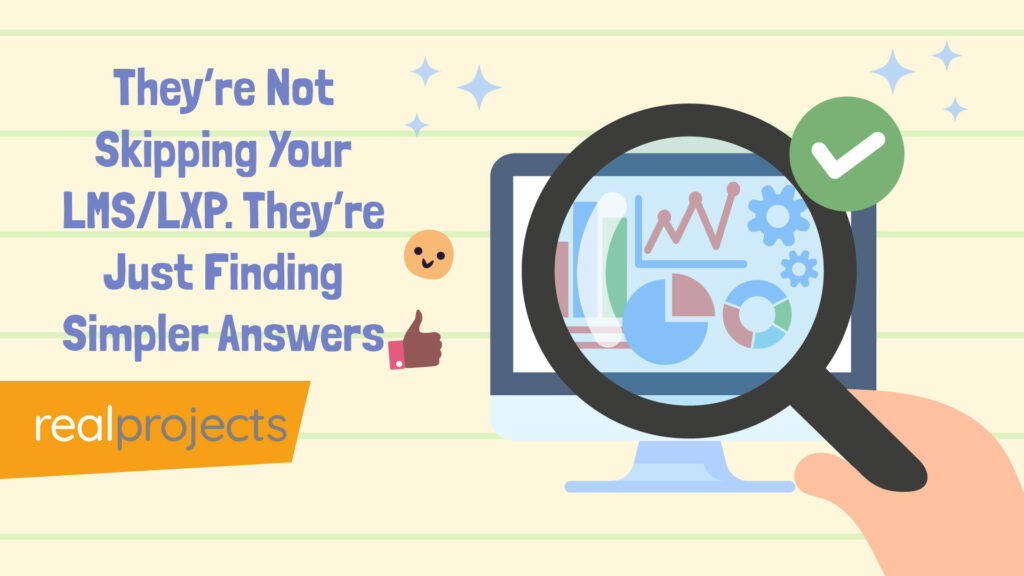Microlearning helps people learn faster, remember more, and stay engaged. It fits into busy days and actually makes training stick.
It’s not just about making things shorter.
It’s about being focused, built around one goal, delivered at the right moment, and designed for the way people really work.
How does Microlearning impact your organisation?
Used well, microlearning can cut training time by 40% and increase engagement by 50%. But you need a plan, it’s not about shorter videos.
Most teams focus on time or tools. But real microlearning is about fit for the task, the moment, and the learner.
Before you scale
- Pick one goal per micro piece
- Match the format to the moment
- Design for action, not just info
- Use micro for prep, follow-up, or performance support
- Keep it personal, useful, and short
Have you been in a meeting and someone has said ‘let’s go micro’ or you’ve just been asked ‘just make it micro’. Normally you get the request without much information to work with.
Whether you’re an L&D lead, an instructional designer, interactive designer or Director you’ve heard the term microlearning even if it’s not part of your current learning strategy.
It wouldn’t be unusual if someone has chucked the phrase “microlearning” your way and expected you to magically shrink down an entire training programme.
It could be a paper course, an elearning course or an animation. Someone has come in and asked for something – let’s make it micro.
Even experienced professionals, people with 10+ years, often admit they’re still figuring out how to go micro in a way that’s meaningful. It might not even be the right way forward, but it’s helpful to know what microlearning is and how you can use it.
The term is tossed around so much that we forget to stop and ask: what does it actually mean? And it’s worth remembering that in its current guise microlearning and the platforms that support it are all still quite new.
So, what is microlearning, really?
You’ll have seen a LEGO set at some point. Imagine that you have to put one together. Microlearning isn’t the full LEGO castle. It’s the single bricks.
Each one has a job. It’s focused, specific, and purposeful. Put enough of them together, and you get something powerful. Also just like the complex LEGO sets or the TECHNIC sets you can add little elements to provide a little something different.
Here’s why microlearning matters:
80% better retention when microlearning is used compared to traditional learning. (RPS Research)
17% more efficient learning when using microlearning strategies. (Journal of Applied Psychology via Training Industry)
Over 50% of employees prefer learning in short bursts under 10 minutes. (Deloitte, Meet the Modern Learner)
Microlearning increases engagement by 50% compared to longer formats. (Software Advice, 2022)
Corporate training time is down 40% when microlearning is used effectively. (Shift Learning)
Most people define microlearning by time. “It’s under five minutes” or “Less than 15 minutes, max.” And yes, short matters, but it’s not the whole story. For most people microlearning is under 5 minutes, but let’s not get too concerned about the time. It’s about how you use and deploy microlearning.
Microlearning is content that’s intentionally shortened to fit seamlessly into someone’s day. It’s digital. It’s accessible.
It’s just in time. And it’s always built around a single objective. You need to think about the why and not focus only about the time.
Scott Hewitt asks: The one thing I wish stakeholders understood? Microlearning isn’t a shortcut. It’s a design choice. It’s about fit: fit for the moment, the workflow, the attention span, and the task.
Four Use Cases: Not All Microlearning Is the Same
There are four common use cases for microlearning:
- Preparation – Use it before a bigger piece of training to build baseline knowledge or get people in the right mindset.
- Follow-Up – Reinforce something they’ve already learned. Think of it as a reminder that locks the learning in.
- Standalone – Bite-sized, self-contained modules. Each delivers on one learning goal. Ideal for libraries or self curated training.
- Performance Support – Help people in the moment. On the floor. At the desk. Wherever the work happens. This is micro at its most practical.
Most people tend to favour Standalone and Follow-Up approaches, but each use case has its value within an organisation. Knowing which one you’re designing for makes everything else easier.
Format Matters (More Than You Think)
PDFs files, Infographics, Short videos, Interactive elearning, Chatbots and Podcasts can all be part of your content strategy for your microlearning content. It could be a QR code that linked to job role content.
Think about how you integrate this content into your microlearning strategy and how you deploy it. It doesn’t always need to be via an LMS. The QR code might be available within the workplace for people to access via a mobile device.
Scott Hewitt asks: Most L&D teams focus too much on the format. They think microlearning just means “make it shorter,” but it’s not about shrinking content. It’s about using it intentionally. You need a strategy, not just shorter videos. And it doesn’t always have to live in the LMS. QR codes, emails (use whatever works).
It’s not about chasing a using the latest tool. It’s about choosing the right format for the use case. You need to make sure that you have a review process to ensure that you are using the right tool and also the content works before you deploy it.
Five Tips to Make Micro Work
Scott Hewitt asks: If you’re trying to build a stronger microlearning strategy, don’t design around the content. Design around the problem. What’s the real need at that moment? Preparing for a tough meeting? Mid-task and stuck? That’s your focus. Sharper content. Better outcomes.
- Be Specific: Select one learning objective. The more specific you are, the more useful the microlearning becomes. Think: “Dealing with a customer return” instead of “Customer service.”
- Be Brief: You can’t fit everything. Give them what they need and nothing more. If the topic is task-based, two minutes might be plenty. If it doesn’t fit that microlearning might not be the solution.
- Be Engaging: People won’t learn if they’re bored. Engagement isn’t about gimmicks. It’s about making them care enough to keep going.
- Be Performance-Focused: What do they need to do better, faster, or safer?
- Be Learner-Centred: Make it personal. Ask them to apply it to their own life. A quick question or pause for thought can make the learning stick.
So Where’s It Headed?
Scott Hewitt adds: ‘We’ve got platforms that make it easier to deliver and measure microlearning. We can move faster, design smarter, and support people right in the flow of work.
With generative AI on the rise, microlearning is about to get even more personalised, more responsive, and more embedded in the flow of work. Expect smarter systems that serve up content when it’s needed, not just when it’s scheduled.
But the fundamentals won’t change. Be brief. Be relevant. Be useful.’
Take This With You
- Know your use case before you design
- Pick the format that fits the moment
- Focus on one objective at a time
- Think job-first, learner-first
- Keep it short, smart, and simple
Microlearning isn’t just about size. It’s about strategy. And when you get it right, it’s one of the most powerful tools in your L&D toolkit. If it doesn’t feel right, then don’t force it. You might need a different learning strategy or deployment tool.
The right microlearning strategy can improve everything from onboarding to performance support, without adding complexity.
Now the next time someone says, ‘Can you just make it micro?’ You’ll know exactly what to ask next.



